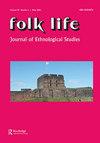冷铁:爱尔兰渔民职业传说的各个方面
IF 0.1
4区 社会学
0 FOLKLORE
引用次数: 1
摘要
传统Roy Fenton对Greensleeves Morris Men的描述要务实得多(在1926年球队成立的“早期复兴”部分,尽管该描述可以追溯到最近)。这是一本很好的回忆录,对未来的作家来说也是很有用的素材,但除了对团队的简要描述之外,它并没有太多用处。这本书倒数第二节讨论了“莫里斯时代的女人”这一主题。Sally Wearing讲述了女子舞蹈队在处理表演的感知问题以及传统、复兴和性别的互动问题时所做的服装选择。主要关注20世纪70年代的新女子舞蹈队,对早期的影响、先例、适合性和时尚性进行了一些深思熟虑的考虑。瓦尔·帕克对妇女莫里斯联合会(1975–1983)及其发展为莫里斯联合会进行了非常好的第一手描述。露西·赖特(Lucy Wright)给了我们一篇生动而迷人的文章,它正确地引起了人们对女性狂欢节莫里斯传统的关注,这一传统被低估但充满活力,数量众多。有时被轻蔑地称为“蓬松的莫里斯”,这种充满活力的舞蹈传统在户外蓬勃发展,与民间复兴无关。一个多世纪以来,这种做法没有受到与过去联系的特殊方式的影响,已经形成了自己的方式。露西·赖特(Lucy Wright)没有发现狂欢节莫里斯运动的参与者希望将自己与民间复兴联系在一起,或将自己与之联系在一起。这本书的最后一节题为“物质文化”,由两篇文章组成。克洛伊·梅特卡夫(Chloe Metcalf)问道:“为什么莫里斯舞者穿白色?”?她试图用一种微妙的方式来回答这个问题,她称之为“语用分析”,并拒绝“普遍”的色彩象征。她提出了一个很好的讨论,强调了许多莫里斯舞者接管他们的表演的思想和关怀,并以一种有效的批评方式处理了对舞者服装的旧解释。在最后一篇文章中,大卫·佩茨关心文物保护和纪念的问题。在这里,联合国教科文组织对有形和非物质遗产的概念被用于讨论博物馆中莫里斯用具的代表性,以及“在城市和乡村景观中创建纪念莫里斯的正式图案”(347),特别是牌匾的放置和道路的命名。这篇高度集中的文章有一种悲哀。正如佩茨所说的。这些传统的最终表达是在表演本身的短暂和流逝的时刻”(332)。一个人是否需要纪念正在生活和繁荣的事物,还是这一行为标志着一个已经走过的阶段?墙上的牌匾和莫里斯团队现场表演的兴奋感之间的差异似乎本质上如此不同,如此之大,以至于人们很难想象它们之间的差距。总之,这是一本令人满意的书,显示了大量莫里斯舞蹈研究的成熟。这种成熟体现在作品的质量、思想的激发、对维多利亚式生存理论的拒绝,以及对更接地气、更有趣的调查类型的支持,以及贡献者(几乎)的性别平衡。作为一个现在发现实体书是一种负担,更喜欢从电子设备上阅读的人,一个人可以免费获得一本30英镑的PDF书的想法既新颖又受欢迎,而且在这些项目的资金来源方面有点令人担忧。本文章由计算机程序翻译,如有差异,请以英文原文为准。
Cold iron: aspects of the occupational lore of Irish fishermen
tradition. Much more down-to-earth is Roy Fenton’s account of the Greensleeves Morris Men (in ‘The Early Revival’ section as the team was founded in 1926 although the account goes up to recent times). This is good as a memoir and useful as source material for future writers, but does not go much beyond a brief account of the team. The penultimate section of the book deals with the subject of ‘Women in Morris’. Sally Wearing gives an account of costume choices made by women’s dance teams as they navigated the perceived issues of presentation and the interacting concerns of tradition, revival and gender. Mostly concerned with the new women’s dance teams of the 1970s, there are some thoughtful considerations of the influence of earlier periods, precedents, suitability and fashion. Val Parker gives a very good first-hand account of the Women’s Morris Federation (1975–1983) and its development into The Morris Federation. Lucy Wright gives us a lively and fascinating essay which rightly draws attention to the underresearched but vibrant and significantly numerous tradition of women’s carnival morris. Sometimes dismissively referred to as ‘fluffy morris’, this vigorous dance tradition has flourished outside and with no regard to the folk revivals. Unburdened by those particular ways of relating to the past, this practice has forged its own way for more than a century. Lucy Wright has discerned no wish from participants in the carnival morris movement to associate themselves with or see themselves in any way connected to the folk revival. The last section of the book is titled ‘Material Culture’ and consists of two essays. Chloe Metcalf asks ‘Why do Morris Dancers Wear White? She tries to answer the question in a subtle way using what she calls ‘pragmatic analysis’ and rejecting ‘universal’ colour symbolism. She presents a good discussion that emphasizes the thought and care that many morris dancers took over their presentation and deals in an effectively critical way with older explanations of dancers’ costumes. In the final essay, David Petts concerns himself with questions of artefact preservation and memorialization. Here the UNESCO notions of tangible and intangible heritage are used to discuss the representation of morris paraphernalia in museums and ‘the creation of formal patterns of commemoration of morris within both urban and rural landscapes’ (347), particularly the placing of plaques and naming of roads. There is a sort of sadness to this highly focussed essay. As Petts remarks ‘. . .the ultimate expression of these traditions is in the transient and passing moment of performance itself’ (332). Does one need to memorialize that which is living and flourishing, or does the act mark a stage which has been passed through? The difference between a plaque on the wall and the excitement of a live performance by a morris team seems so different in essence, so large, that the gap between them can hardly be thought. All in all this is a satisfying volume that shows the maturity of a great deal of morris dance research. That maturity is attested in the quality of the work, the stimulation of the ideas, the rejection of Victorian type survival theories in favour of more grounded and interesting types of enquiry and the (almost) gender balance of the contributors. As someone who now finds physical books an encumbrance and prefers to read from electronic devices, the idea that one can get a £30 book free as a PDF is both novel, to be welcome and slightly worrying in terms of how such projects are funded.
求助全文
通过发布文献求助,成功后即可免费获取论文全文。
去求助
来源期刊
CiteScore
0.30
自引率
66.70%
发文量
17
期刊介绍:
Folk Life: Journal of Ethnological Studies is a journal devoted to the study of all aspects of traditional ways of life in Great Britain and Ireland. The journal publishes original, high quality, peer-reviewed research in the form of unsolicited articles, solicited papers (which are usually selected from those read at the Society"s annual conference) and of members" papers (which are usually short reports of work in progress). Work published in Folk Life may include, for example, papers dealing with the traditional ways of life of other countries and regions, which may be compared to or contrasted with those of Great Britain and Ireland.

 求助内容:
求助内容: 应助结果提醒方式:
应助结果提醒方式:


